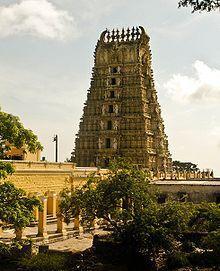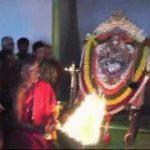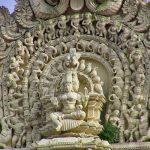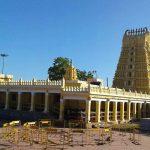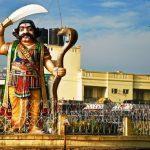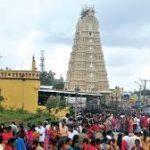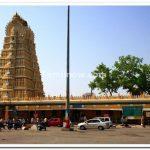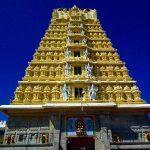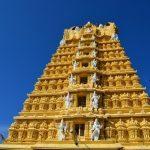Chamundeshwari Temple, Mysore, karnataka
| Date built: | – |
|---|---|
| Deity: | – |
| Architectural style: | – |
| Major festivals | Navaratri |
| Locale: | Chamundi Hill |
| District:: | Mysore |
| Address: | – |
| Phone | – |
The Chamundeshwari Temple is a Hindu temple located on the top of Chamundi Hills about 13 km from the palace city of Mysore in the state of Karnataka in India.The temple was named after Chamundeshwari or Durga, the fierce form of Shakti, a tutelary deityheld in reverence for centuries by Mysore Maharajas.
Chamundeshwari is called by the people of Karnataka as Naada Devathe which means State Goddess
Architecture
The original shrine is thought to have been built in the 12th century by Hoysala rulers while its tower was probably built by the Vijayanagar rulers of the 17th century. In 1659, a flight of one thousand steps was built leading up to the 3000-foot summit of the hill.[2] At the temple are several images of Nandi (the bull mount of Shiva). There is a huge granite Nandi on the 700th step on the hill in front of a small Shiva temple a short distance away. This Nandi is over 15 feet high, and 24 feet long and around its neck are exquisite bells.
The temple is famous for the celebrations of festivals like Aashada Shukravara, Navaratri and Ammanavara Vardhanthi. In the month of Ashadha, Fridays are considered particularly auspicious. Lakhs of devotees throng the temple during this occasion. Another festival celebrated during this month is Chamundi Jayanti. This day is celebrated on the anniversary of the consecration of the utsava murthy of the goddess by the Maharaja of Mysore. On this occasion, the goddess’s icon is taken around the temple in a golden palanquin.
The most important festival that is celebrated here is Navaratri. Mysore Dasara is celebrated as the state festival of Karnataka, called Nadahabba in Kannada. During Navaratri, the Goddess is decorated in 9 different ways to depict nine different aspects of the goddess. On the 7th day of Navaratri that is Kaalaratri, valuable jewels donated by Maharajas are brought from the District Treasury of Mysuru and decorated to Chamundi.
Another temple is situated at the foothill which is in Utthanahalli called as Jwalamuki Shri Tripurasundari Temple. This goddess is considered the sister of Chamundi who helped her at the battlefield to slay the demon Raktabīja.
Legend / Local stories
Chamundi Hill is about 13 kms from Mysuru, which is a prominent city in Karnataka State of India. Chamundi Hills is famous not only in India but also abroad. ‘Chamundi’ or ‘Durga’ at atop of the hil, the famous Sri Chamundeswari Temple is the fierce form of ‘Shakti’. She is the slayer of demons, ‘Chanda’ and ‘Munda’ and also ‘Mahishasura’, the buffalow-headed monster.
She is the tutelary deity of the Mysore Maharajas and the presiding deity of Mysore. For several centuries they have held the Goddess, Chamundeswari, in great reverence.
In ‘Skanda Purana’ and other ancient texts, it is mention a sacred place called ‘Trimuta Kshetra’ surrounded by eight hills. lying along side of west is the Chamundi Hills, it is one among the eight hills. In the earlier days, the hill was identified as ‘Mahabaladri’ in honour of God Shiva who resides in the ‘Mahabaleswara Temple’; this is the oldest temple on the hills.
In the later days, the hill came to be known as ‘Chamundi Hills’ in honour of the Goddess Chamundi, the chief subject of the ‘Devi Mahathme’. The Goddess is believed to be an incarnation of Parvati, the consort of Lord Shiva. A large number of devotees from all over the country and also from abroad visit the temple every year. They believe that the Goddess fulfills their desires and aspirations.
Chamundi Hills rises to a height of 3,489 feet MSL and is visible from a distance itself while traveling towards Mysuru. There is a good motorable road to the top. Besides from Mysuru side, there is also a motorable road from its rear side, i.e.road goes to Nanjangud. City Bus facilities are available to visit the hills. Karnataka State Road Transport Corporation (KSRTC) operates regular bus services every day for the convenience of pilgrims and others.
A temple of great antiquity with over 1,000 years of history, it was a small shrine initially and assuming importance over the centuries it became a big temple as seen today. It is being assumed significance after the Mysuru Maharajas, the Wodeyars, came to power in 1399 A.D., who are great devotees and worshippers of the Devi, Chamundeswari became their home deity and thus assumed religious prominance.
The crowning glory of Mysuru, Chamundi Hills is an enchanting place surrounded by natural beauty. In the forest, there are varieties of trees, birds and animals. While going up the hills, a bird’s eye view of Mysore can be seen and several prominent places be spotted. It offers a spectacular scene when the Palace and its surroundings are illuminated during the Dasara and other occasions.
Some of the places that can be spotted from the hills are the Palace, Lalitha Mahal Palace, which houses the ITDC hotel, Dasara Exhibition grounds, Race Course, Golf Ground Kukkarahalli Lake, St. Philomena’s Church, and Krishnarajasagar (K.R.S) at a far off distance.
Besides the Chamundi and the Mahabaleswara temples, there are a few more temples are at atop the hills. There are also some interesting spots and the monolith statue of ‘Nandi’ is among them. While proceeding towards the Chamundi Temple, the statue of ‘Mahishasura’ attracts the visitors. The ‘Chamundi Village’ is located close to the temple.
The Architecture of the Chamundi Temple: The temple is of a quadrangular structure built in Dravidian style, it consists of the Main Doorway, Entrance, Navaranga Hall, Antharala Mantapa, Sanctum Sanctorum, and Prakara. There is a beautiful seven-tier Gopura or pyramidal tower at the entrance and a ‘Vimana’ (small tower) atop the sanctum sanctorum. Atop the ‘Shikara’, the tower at the entrance, are seven golden ‘Kalashasa’.
Krishnaraja Wodeyar III repaired the shrine in 1827 A.D and built the present beautiful tower at the entrance (Gopura). Blessed by the Goddess, Krishnaraja Wodeyar, an ardent devotee of the mother Goddess, presented‘ Simha-vahana’ (A lion-shaped vehicle) and other animal cars and jewels of value to the temple a. The cars are used even now for processions on special religious occasions.
The tower at the entrance has a small image of Lord Ganesha on the doorway. The doorway is silver-plated and has the images of the Goddess in different forms. On either side of the doorway have images of ‘Dwarapalakas’ or door-keepers. As one enters inside, on the right hand side is a small statue of Lord Ganesha, the remover of all obstacles. After a few steps, there is a flagstaff, the footprints of the Goddess and a small statue of Nandi, facing the sanctum sanctorum. On the right side, before approaching the flag staff, there is an image of ‘Anjaneya’ attached to the wall. On either side of this entrance are two Dikpalakas, Nandini and Kamalini.
In the ‘Antharala’ prior to the sacred sanctum sanctorum are the images of Lord Ganesha on the left side and of ‘Bhyrava’ on the right side. To the left of Ganesha, there is a beautiful 6-foot statue of Maharaja Krishnaraja Wodeyar III. He is standing with his hands folded in his religious costumes. On either side of him are his three wives, Ramavilasa, Lakshmivilasa and Krishnavilasa. Their names are carved on the pedestals. In the sanctum sanctorum is the stone statue of the Goddess, ‘Mahisha Mardhini’ having ‘Ashta Bhujas’ or eight shoulders, she is in a seated posture. According to the local legend, the image was established by sage Markandeya and hence it is said to be very old.
The idol of the Goddess is decorated every day and worshipped by a number of priests. The Mysore Maharajas have donated number of valuable gifts to their family deity.Coconuts, fruits and flowers are offered to the diety. On top of the sanctum sanctorum, a small tower or ‘Vimana’ is seen. In the ‘Prakara’ or enclosure, behind the sanctum sanctorum, are small images of a few deities, which are also worshipped.
Photo Gallery
How to Reach:
Contact Details
Official Address

